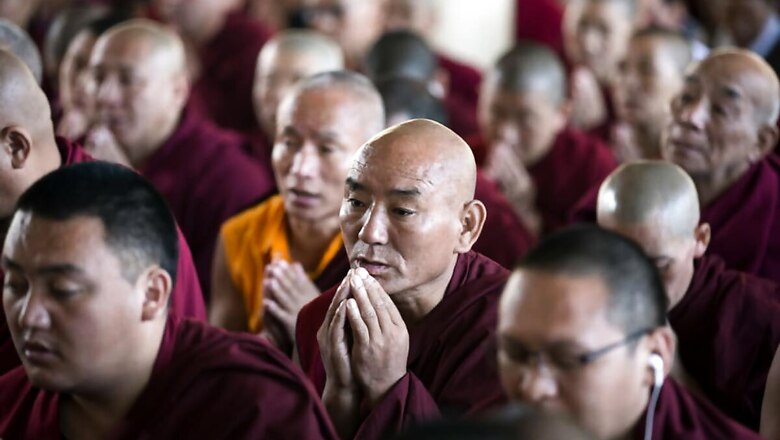
views
The Biden Administration, in its first direct message to China on Tibet, has reminded Beijing that it shouldn’t have any role in the Dalai Lama’s succession, thus continuing the hardline taken by the previous Trump administration on Tibetan issue.
The US States Department spokesperson, Ned Price, has reiterated the Trump Government line, adding that the Chinese obstruction in the process is an ‘outrageous abuse’.
The US has adopted a tough approach on human rights violations in China and the current US President Joe Biden has made it very clear that there will be ‘repercussion for China.’
The US Congress in December 2020 passed the Tibetan Policy and Support Act of 2020 (TPSA) and Donald Trump soon signed it to make a law that officially confirms the US stand on the Dalai Lama reincarnation system. The act says that the authority of the current Dalai Lama is the sole deciding factor in the reincarnation process of the next Dalai Lama and warned China of possible serious sanctions if the country did intervene. The act also calls for establishment of a US Consulate in Tibetan capital Lhasa.
The TPSA also calls for sustainability of Tibetan religion and language that defines the Tibetan culture and specifically talks about the threat they are facing in China. Tibetan lives are weaved with their religion, culture and language. They have this inheritance that doesn’t allow to them to accept the Chinese rule.
Sinicisation – the cultural genocide in Tibet
US watchdog Freedom House says even North Korea is freer than Tibet. In its ‘Freedom in the World’ report, Tibet finds a place just below South Sudan and North Korea.
Mao Zedong once told the Dalai Lama that religion was poison and he went on to destroy the Tibetan religious and cultural practices till he breathed his last. He started a process, the sinicisation of Tibet, or to mend the Tibetan life and culture the way the Chinese Communist Party wants to or to make them submissive to the Chinese interests or to assimilate them in the Han Chinese culture.
China initially mocked the soul of Tibetan culture and existence.
Tibetan Buddhism follows the tradition of reincarnation, or re-birth, of Living Buddha positions. The Dalai Lama and the Panchen Lama, two most important spiritual authorities of Tibet, follow the spiritual re-birth path to their successive positions. The Dalai Lama is Tibet’s highest spiritual and political authority. The Panchen Lama is the second highest spiritual authority. An elaborate method has been put in place that takes years to find the next Dalai Lama and the Panchen Lama.
The whole Tibetan culture is weaved around the institution of the Dalai and is supported by a monastic culture of teaching Buddhism and is an inseparable part of Tibetan lives.
But for Chinese, it used to be just a folk ritual initially. In 1995, the Dalai Lama recognised a six-year-old boy Gedhun Choekyi Nyima as the 11th Panchen Lama. But only three days later, China not only kidnapped and arrested the boy but also appointed a new Panchen Lama and that too by using a lottery, in a mockery of the tradition that has been followed for centuries. And to make the mockery complete, the parents of the new Panchen Lama were members of the Chinese Communist Party.
China initially used to call the Tibetan reincarnation system a feudal one as it saw the institution of the Dalai Lama a parallel power centre.
Tibetan monasteries are the core of the Tibetan culture but China saw them as alternate power base and destroyed almost all monasteries that greater Tibet region had, near about 6,000 Buddhist monasteries by 1976, the year Mao Zedong died. Religious manuscripts were burned and statues were removed and sent to China. Greater Tibet region means the whole Tibetan areas in China including the current province officially known as Tibet.
In Tibet Autonomous Region, the Chinese oppression was more fatal. According to a petition submitted by the Panchen Lama in 1962 to the Central Chinese Authorities, between 1950 and 1962, China destroyed 97% of the 2,500 Tibetan monasteries. The greater Tibet region had 110,000 monks and nuns, the carrier of Buddhist traditions. By 1962, just 7%, or 7,000, of them were left in Tibet. Some fled abroad while most were disrobed by the Chinese government.
Teaching Buddhism was an important part of the Tibetan culture but China has totally obliterated the Buddhism teacher-student system, with teachers either killed, or exiled (like the Dalai Lama) or imprisoned for long durations, sometimes for over 20 years. The Chinese government also forced young monks to leave monasteries.
But China failed even after this fatal level of oppression. Be it the Mao’s Cultural Revolution years or the 1995 mockery or the fight for the Tibetans’ rights now, Tibetans have always followed and continue to follow their own culture and tradition and still see their guiding light in the institution of the Dalai Lama.
Something that forced China to create a sinicised religious structure
Because China thought it was the best way to keep Tibetans in line, if their top religious institutions and leaders and be controlled. And the first step of it was a sham apologetic exercise.
In 1980, the Chinese Communist Party publicly apologised for the excesses done during the Mao’s rule. The Chinese government said it would re-establish the Tibetan culture and identity and according to a report by the Global Times, one of the Chinese media state publications, TAR now has over 1,700 Tibetan monasteries and more than 46,000 monks and nuns.
And these monasteries today look totally sinicised or under Chinese control.
China passed a policy in 2011, “Complete Long Term Management Mechanism of Tibetan Buddhist Monasteries”. The management committee under this policy has up to 30 officials appointed by the Chinese government to look into the rituals and practices of a monastery and a Chinese officer is placed above the senior most Tibetan monk to see and assure that nothing anti-China is being included. The Chinese government is also trying to convert these monasteries into a Chinese propaganda organ that can bend the thinking of future generation Tibetans.
Another example of the Chinese attempt to sinicise the Tibetan culture is its efforts to capture the institution of the Dalai Lama.
In 2007, China’s State Administration for Religious Affairs passed an order, ‘Reincarnation of Living Buddhas in Tibetan Buddhism’ that made it mandatory for the reincarnations to have the Chinese government approval; otherwise they would be termed “illegal or invalid’.
It is a direct challenge to the authority of the Dalai Lama. Now we may have two Dalai Lamas in future, one in India and one in China, as the current Dalai Lama says that China is not going to approve the choice taken independently by Tibetans.
And to complete its oppression cycle, it is replacing Tibetan language with Mandarin.
Even nursery schools in Tibetan areas now completely teach in Mandarin and the number of Tibetans in universities who can barely speak their mother tongue is going up. In fact, China arrested a popular Tibetan singer Gonpo Tenzin for requesting Tibetans to preserve their language and culture through a message from his album ‘No New Year for Tibet’. He was detained in 2013 and sentenced in 2015 for three and half years.
Read all the Latest News, Breaking News and Coronavirus News here




















Comments
0 comment